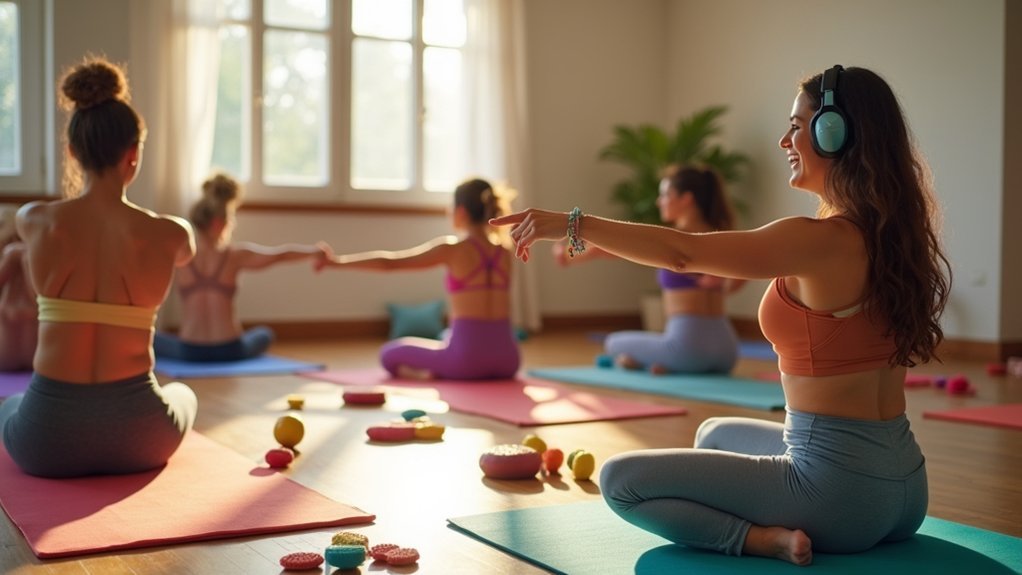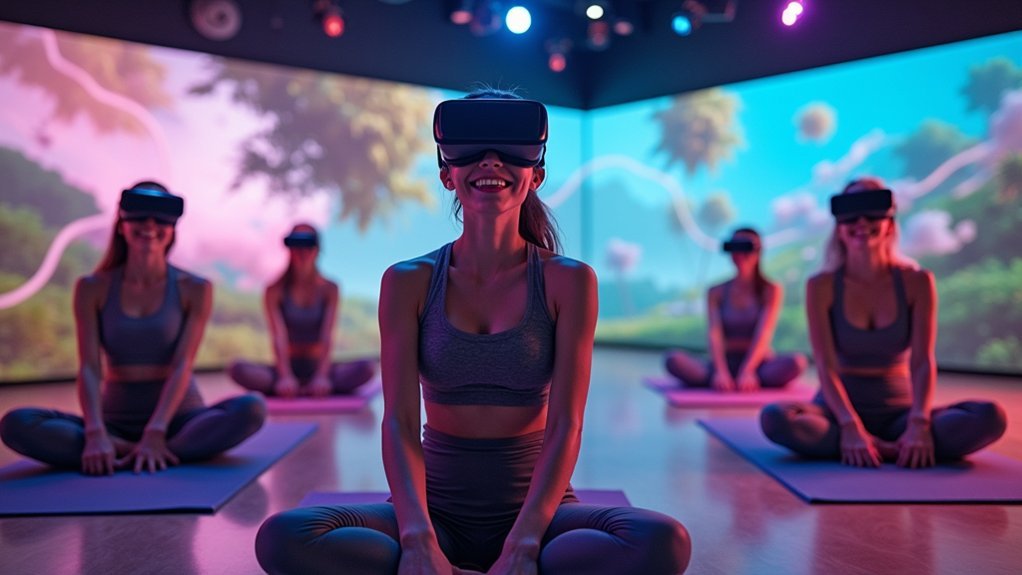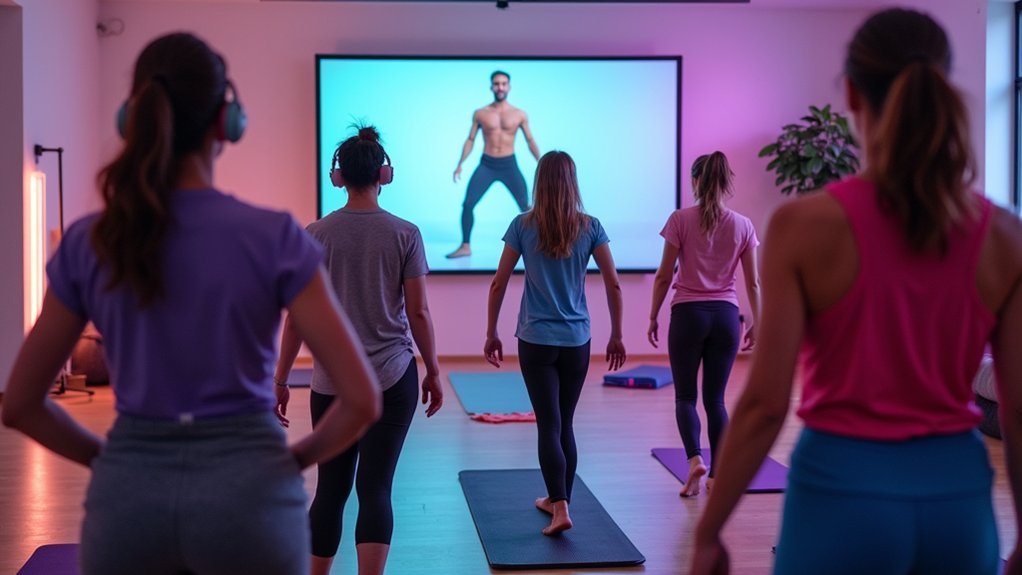Virtual fitness platforms now offer unprecedented accessibility for diverse sensory needs. You’ll find customizable audio settings with adjustable intensities, visual modifications to reduce overwhelm, and adaptive motion tracking that recognizes even micro-movements. These platforms create therapeutic environments with personalized sensory profiles, helping you exercise without judgment or sensory overload. With AI-powered form correction and wearable technology integration, the $7.4 billion market continues evolving to support your specific needs. Discover how these innovations are transforming lives through tailored digital fitness experiences.
The Rise of Sensory-Inclusive Virtual Fitness Platforms

As the needs of diverse populations gain recognition, the virtual fitness market for people with disabilities has expanded dramatically, reaching approximately $2 billion in 2024 with projections to hit $7.4 billion by 2032.
This growth isn’t surprising—30% of people with disabilities report needing fitness programs tailored to their specific limitations.
You’ll find an encouraging shift as over 25% of disabled users now actively engage with digital fitness solutions. This adoption reflects the industry’s response to real demand, with growth rates between 8-22% annually. The market is actually projected to reach USD 10,994.92 million by 2033, significantly outpacing previous estimates.
The expansion is further supported by telehealth advancements and inclusive technology initiatives worldwide. As platforms evolve to accommodate various sensory needs, you’re witnessing a transformative moment where digital fitness becomes truly accessible to everyone.
Customizable Audio and Visual Settings in VR Fitness
You’ll find today’s VR fitness platforms offer impressive flexibility with adjustable sensory intensities that can decrease visual clutter or sync audio with your physical performance.
Most systems now provide multi-sensory feedback options, allowing you to customize which senses receive workout cues—whether through vibration, audio indicators, or visual signals.
Creating personalized sensory profiles helps tailor your virtual workout environment to your unique preferences, accommodating sensitivities while maintaining an effective exercise experience. Advanced platforms like Black Box VR implement adaptive audio systems that dynamically respond to your workout intensity and performance metrics.
Adjustable Sensory Intensities
When entering a virtual reality fitness environment, users need control over their sensory experience to maintain comfort and motivation. You’ll find most modern VR fitness platforms offer granular adjustments for both audio and visual elements that can dramatically impact your workout experience. HOLOFIT provides diverse virtual environments for engaging workouts that adapt to different sensory preferences.
| Sensory Element | Adjustment Options | Benefits |
|---|---|---|
| Audio | Volume, music selection, tempo | Maintains motivation, reduces distraction |
| Visual | Environment, lighting, effects | Creates immersion, accommodates sensitivity |
| Feedback | Haptic intensity, visual cues | Provides accomplishment markers, reduces overwhelm |
These customization options aren’t just for preference—they’re essential for accessibility. By adjusting sensory intensities, you’ll experience fewer distractions and greater workout effectiveness. The synchronization between audio cues and visual feedback creates a cohesive experience that adapts to your needs, whether you’re sensitive to bright environments or motivated by upbeat music.
Multi-Sensory Feedback Options
Modern VR fitness platforms thrive on their ability to deliver extensive multi-sensory feedback that transforms ordinary workouts into immersive experiences.
You’ll benefit from customizable audio settings that increase perceived activation during exercise, while narrative-based gamification enhances engagement. For those with auditory sensitivities, adjustment options guarantee comfort, with the ability to replace audio with visual or haptic cues.
Visual settings offer similar flexibility, allowing you to modify sensitivity levels and create comfortable environments by reducing overwhelming elements. Immersive 360-degree visual experiences increase activation while providing real-time form correction feedback to improve your technique. The technology adapts to your skill level, offering personalized workouts that accommodate physical limitations and adjust difficulty based on your performance.
This multi-sensory approach improves engagement, enhances performance, and increases accessibility across diverse abilities.
As haptic technology and wearable device integration advance, you’ll experience even more personalized feedback tailored to your unique needs.
Personalized Sensory Profiles
Personalized sensory profiles represent the cornerstone of effective VR fitness platforms, allowing users to create uniquely tailored exercise environments that match their individual needs.
You’ll find options to adjust audio elements—volume, frequency filtering, and spatial placement—to accommodate your auditory sensitivities while selecting sounds that enhance your motivation or relaxation.
Visual customization lets you modify brightness, contrast, color schemes, and complexity levels to prevent sensory overload. You can reduce visual triggers like flashing lights or choose simplified environments that maintain your comfort during workouts.
These adaptable settings markedly improve relaxation, reduce anxiety, and combat workout monotony.
For neurodiverse users, these personalization options create emotionally safe spaces that support longer, more productive exercise sessions while building sensory tolerance in controlled, safe contexts. The importance of these customizations is underscored by research showing that proper sensory environments can substantially improve cognitive function in individuals with autism.
Adaptive Movement Tracking for Limited Mobility Users
Adaptive movement tracking has revolutionized VR fitness for you if you have limited mobility, with motion sensors now capable of detecting even micro-movements from various body parts.
You’ll benefit from AI-powered form correction that analyzes your available range of motion and provides real-time guidance tailored to your specific abilities.
Partial movement recognition technology allows you to complete exercises and games with whatever mobility you have, translating fractional gestures into full in-game actions. Similar to Tobii Dynavox technology, these systems offer gaze tracking capabilities that complement physical movement detection for a more comprehensive fitness experience.
Motion Sensors Reimagined
While traditional fitness tracking once required full-range mobility to capture meaningful data, today’s reimagined motion sensing technologies have revolutionized accessibility for users with limited mobility.
You’ll find both wearable and sensorless options designed with your diverse needs in mind.
Wearable sensors offer precision tracking by attaching to your body, capturing even subtle movements with remarkable accuracy.
Meanwhile, sensorless systems leverage AI and computer vision, freeing you from physical attachments altogether—ideal if you struggle with wearing devices. These systems can transform any camera into a portable motion tracker, eliminating the need for expensive equipment while maintaining effectiveness.
Machine learning fusion techniques enhance these systems by combining multiple data streams, providing personalized analysis tailored to your specific mobility profile.
The integration with IoT enables continuous monitoring and real-time feedback, making your fitness journey more accessible whether you’re in rehabilitation or simply pursuing an active lifestyle.
AI-Powered Form Correction
Because traditional exercise guidance often fails to accommodate mobility differences, AI-powered form correction technology has emerged as a game-changer for users with limited mobility. This technology creates adaptive workout plans tailored to your specific limitations while providing real-time voice guidance.
You’ll benefit from AI’s ability to suggest alternative movements when certain exercises prove challenging, ensuring you can still effectively target muscle groups without risking injury. The system continuously monitors your performance, reducing injury risk by up to 40% through instant form corrections.
Unlike rigid fitness programs, AI adapts to your progress, helping you overcome plateaus with personalized adjustments to both exercises and nutrition plans. ReflectAI® technology powers these features with instant form correction capabilities that enhance position, pace, and range of motion for users of all mobility levels.
This accessibility means you can receive expert-level guidance anytime, anywhere—making fitness truly inclusive regardless of your mobility constraints.
Partial Movement Recognition
For those with significant mobility limitations, traditional motion tracking systems often fail to register subtle or partial movements, making virtual fitness participation nearly impossible.
Today’s adaptive technologies are changing this reality with non-intrusive monitoring solutions that detect even minimal finger movements.
You’ll benefit from systems designed with user-centric flexibility that don’t require full-range motions. These technologies incorporate customizable thresholds to accommodate your specific capabilities, ensuring you can control fitness applications with movements you can comfortably perform.
Real-time feedback helps you understand how your actions are being interpreted.
Look for platforms using skeletal motion detection and mathematical models that work across various backgrounds and lighting conditions. Studies have shown the Vector Sum Method can improve slow-motion detection rates by 30-70% compared to conventional motion tracking techniques.
These advancements mean you won’t need to lift your hand or make large gestures to participate effectively in virtual fitness programs.
Wearable Technology Integration for Enhanced Sensory Feedback
As virtual fitness environments become increasingly sophisticated, wearable technology has emerged as a critical bridge between digital exercise experiences and physical sensation.
You’ll benefit from haptic devices that deliver vibration, pressure, and temperature feedback to create immersive workout experiences, regardless of your sensory abilities.
- Flexible, skin-adhering wearables provide spatially distributed tactile sensations, making virtual movements feel more realistic and helping you correct form in real-time.
- Multi-modal feedback systems combine vibration with visual and auditory cues, preventing sensory overload while you focus on exercise performance.
- Personalized haptic feedback patterns can assist with balance and proprioception, making fitness activities safer and more effective for users with diverse sensory processing needs.
Research shows that these technologies can effectively transform body perceptions related to physical activity barriers through interactive sensorial patterns that enhance engagement with exercise.
Creating Therapeutic VR Fitness Environments for Sensory Regulation

Virtual reality has revolutionized therapeutic fitness by creating highly customizable environments that address diverse sensory needs.
You’ll benefit from precise manipulation of visual, auditory, and tactile elements that reduce the overstimulation common in traditional gyms.
VR’s adjustable sensory intensity settings empower you to modify lighting, sound volume, and haptic feedback to match your tolerance levels.
These environments incorporate calming visual patterns and ambient sounds while filtering potentially triggering stimuli.
You’ll experience improved balance and motor function through immersive exercises that support sensory integration.
The controlled exposure to gradually increasing sensory challenges promotes neuroplasticity and sensory-motor recalibration without physical injury risks.
This approach has proven especially beneficial for those with sensory processing challenges, increasing engagement and adherence compared to traditional therapy methods.
Research shows VR training produces large effects on balance capabilities for individuals with chronic stroke conditions.
Success Stories: How Accessible VR Fitness Transforms Lives
The real impact of accessible VR fitness becomes clear through the transformative experiences of individuals who’ve embraced this technology. Veterans like Kari Shulman with multiple sclerosis have gained improved grip strength, while mobility-impaired users like David Chen report enhanced range of motion after six months of tailored VR workouts.
These success stories highlight how VR fitness creates meaningful change:
- Physical improvements become measurable and trackable, with healthcare professionals using tools like dynamometers to document strength gains.
- Mental health benefits emerge alongside physical ones, with users reporting reduced fatigue and increased feelings of connectedness.
- Customizable environments break down traditional barriers, allowing people with diverse sensory needs to exercise without judgment or sensory overload. The engaging nature of VR gaming helps users overcome workout fatigue, turning exercise into an experience where people maintain activity for longer due to VR’s motivational aspects.
Frequently Asked Questions
How Affordable Are Accessible Virtual Fitness Platforms for Individuals With Disabilities?
You’ll find affordable options with many accessible fitness platforms offering free trials or low monthly fees ($5-20). Some require equipment purchases, but overall costs are reasonable compared to traditional gym memberships.
Can Virtual Fitness Tools Integrate With Existing Assistive Technology Devices?
Yes, virtual fitness tools can integrate with your existing assistive devices. They’re increasingly designed with compatibility protocols that allow seamless communication between fitness platforms and technologies like smart prosthetics, hearing aids, and communication tools.
What Qualifications Do Trainers Have for Working With Diverse Sensory Needs?
Trainers working with diverse sensory needs typically have adaptive special needs certifications, sensory integration knowledge, and autism fitness training. You’ll find qualified professionals maintain continuing education in inclusive fitness approaches and personalized program development techniques.
Are There Community Features for Connecting With Similar Users?
Yes, you’ll find workout groups based on shared interests, leadership boards for friendly competition, and social media integration. These tools help you connect with others who have similar fitness goals and sensory preferences.
How Secure Is Personal Health Data Collected During Virtual Fitness Sessions?
Your personal health data faces significant risks during virtual fitness sessions. It’s typically not HIPAA-protected, frequently shared with numerous third parties, vulnerable to breaches, and often collected under vague privacy policies you don’t read.
In Summary
You’ve witnessed the evolution of virtual fitness into a truly inclusive space. By embracing customizable sensory settings, adaptive tracking, and therapeutic environments, you’re part of a revolution that’s breaking barriers. Whether you’re adjusting audio cues, using specialized wearables, or finding peace in sensory-regulated workouts, you’ll discover that accessible VR fitness isn’t just about exercise—it’s about creating pathways to wellness that work for everyone’s unique needs.





Leave a Reply